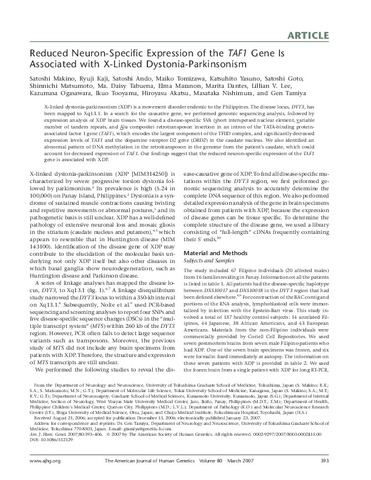Reduced neuron-specific expression of the TAF1 gene is associated with X-linked dystonia-Parkinsonism
| dc.contributor.author | Makino, Satoshi | |
| dc.contributor.author | Kaji, Ryuji | |
| dc.contributor.author | Ando, Satoshi | |
| dc.contributor.author | Tomizawa, Maiko | |
| dc.contributor.author | Yasuno, Katsuhito | |
| dc.contributor.author | Goto, Satoshi | |
| dc.contributor.author | Matsumoto, Shinnichi | |
| dc.contributor.author | Tabuena, Ma. Daisy | |
| dc.contributor.author | Maranon, Elma | |
| dc.contributor.author | Dantes, Marita | |
| dc.contributor.author | Lee, Lillian V. | |
| dc.contributor.author | Ogasawara, Kazumasa | |
| dc.contributor.author | Tooyama, Ikuo | |
| dc.contributor.author | Akatsu, Hiroyasu | |
| dc.contributor.author | Nishimura, Masataka | |
| dc.contributor.author | Tamiya, Gen | |
| dc.date.accessioned | 2021-11-15T08:07:21Z | |
| dc.date.available | 2021-11-15T08:07:21Z | |
| dc.date.issued | 2007-03 | |
| dc.identifier.citation | Makino, S., Kaji, R., Ando, S., Tomizawa, M., Yasuno, K., Goto, S., ... & Tamiya, G. (2007). Reduced neuron-specific expression of the TAF1 gene is associated with X-linked dystonia-parkinsonism. The American Journal of Human Genetics, 80(3), 393-406. | en |
| dc.identifier.issn | 0002-9297 | |
| dc.identifier.uri | http://repository.wvsu.edu.ph/handle/123456789/53 | |
| dc.description.abstract | X-linked dystonia-parkinsonism (XDP) is a movement disorder endemic to the Philippines. The disease locus, DYT3, has been mapped to Xq13.1. In a search for the causative gene, we performed genomic sequencing analysis, followed by expression analysis of XDP brain tissues. We found a disease-specific SVA (short interspersed nuclear element, variable number of tandem repeats, and Alu composite) retrotransposon insertion in an intron of the TATA-binding protein-associated factor 1 gene (TAF1), which encodes the largest component of the TFIID complex, and significantly decreased expression levels of TAF1 and the dopamine receptor D2 gene (DRD2) in the caudate nucleus. We also identified an abnormal pattern of DNA methylation in the retrotransposon in the genome from the patient’s caudate, which could account for decreased expression of TAF1. Our findings suggest that the reduced neuron-specific expression of the TAF1 gene is associated with XDP. | en |
| dc.description.sponsorship | We thank S. Fahn (Neurological Institute of New York, Columbia University) and M. Nakagawa (Kyoto Prefectural University of Medicine) for their critical reading of the manuscript. This study was partly supported by a Grant-in-Aid for Scientific Research on Priority Areas (C) “Medical Genome Science”; by Center of Excellence grant 16101J-1 from the Japanese Ministry of Education, Science, Culture, and Sports; and by Grant-in-Aid for Dystonia Research from the National Center of Neurology and Psychiatry, Japan. | en |
| dc.publisher | Cell Press | en |
| dc.relation.uri | en | |
| dc.subject | Dystonia | en |
| dc.subject | Parkinsonism | en |
| dc.subject | X-linked dystonia-parkinsonism (XDP) | en |
| dc.subject.lcsh | Dystonia | en |
| dc.subject.mesh | Endodeoxyribonucleases | |
| dc.subject.mesh | Genetic Diseases, X-Linked | |
| dc.subject.mesh | Histone Acetyltransferases | |
| dc.subject.mesh | Immunoenzyme Techniques | |
| dc.subject.mesh | Molecular Sequence Data | |
| dc.subject.mesh | Parkinsonian Disorders | |
| dc.subject.mesh | Dystonia | en |
| dc.title | Reduced neuron-specific expression of the TAF1 gene is associated with X-linked dystonia-Parkinsonism | en |
| dc.type | Article | en |
| dc.citation.journaltitle | American Journal of Human Genetics | en |
| dc.citation.volume | 80 | en |
| dc.citation.issue | 3 | en |
| dc.citation.firstpage | 393 | en |
| dc.citation.lastpage | 406 | en |
| dc.identifier.essn | 1537-6605 | |
| dc.identifier.doi | 10.1086/512129 |
Files in this item
This item appears in the following Collection(s)
-
Journal articles published externally [127]
Journal articles published externally, written by WVSU faculty members, staff, and students






